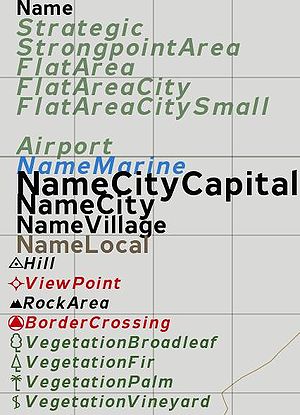Location
Jump to navigation
Jump to search
A location is like an extended type of marker (introduced in ArmA 1.08).
- Locations have a name, a side, a 3D position, a 2D area, and an orientation.
- They have a non-scaling map representation (icon and/or text, depending on class).
- They require a class definition to define basic properties that can be changed using script commands. Classes are defined in bin\Config.bin\CfgLocationTypes
- They can be attached to objects, with all of the location's relevant properties inherited from the object
- They can use setVariable and getVariable, but only works with user made locations [1]
- Locations are local in MP, their properties are not synchronized
- Existing locations are set in an islands .pew file. When the island is exported to .wrp the islandname.hpp is also produced - this contains the location names used in the .pew file. This .hpp is then incorporated into the config for the island using an #include statement.
This section included in the island config ensures any locations set in the .pew file are included the island during packing. - A terrain's config can not be changed using the location script commands, but they can be found and read. This provides a single command method of finding nearby high points, towns, etc.
Location Types
Armed Assault
Possible location types are:
- Mount
- Name
- NameMarine
- NameCityCapital
- NameCity
- NameVillage
- NameLocal
- Hill
- ViewPoint
- RockArea
- BorderCrossing
- VegetationBroadleaf
- VegetationFir
- VegetationPalm
- VegetationVineyard
Arma 2
- Name
- Strategic
- StrongpointArea
- FlatArea
- FlatAreaCity
- FlatAreaCitySmall
- CityCenter
- Airport
- NameMarine
- NameCityCapital
- NameCity
- NameVillage
- NameLocal
- Hill
- ViewPoint
- RockArea
- BorderCrossing
- VegetationBroadleaf
- VegetationFir
- VegetationPalm
- VegetationVineyard
Arma 3
- NameCity
- NameCityCapital
- NameMarine
- NameVillage
- NameLocal (Will return names like Airport)
- Hill
- Mount

